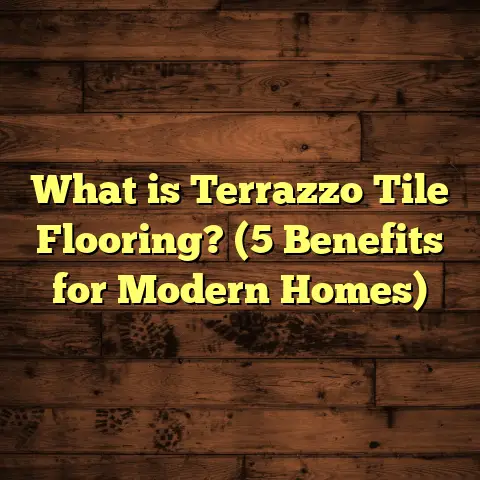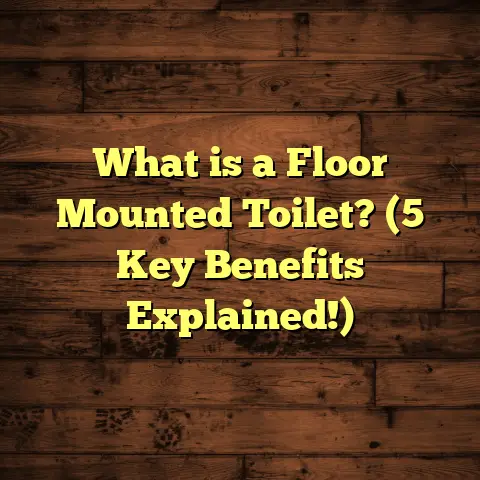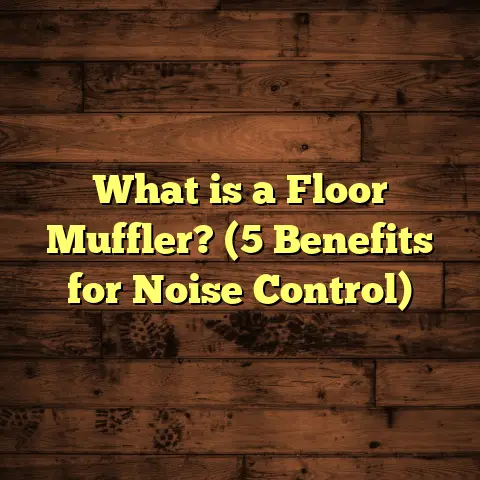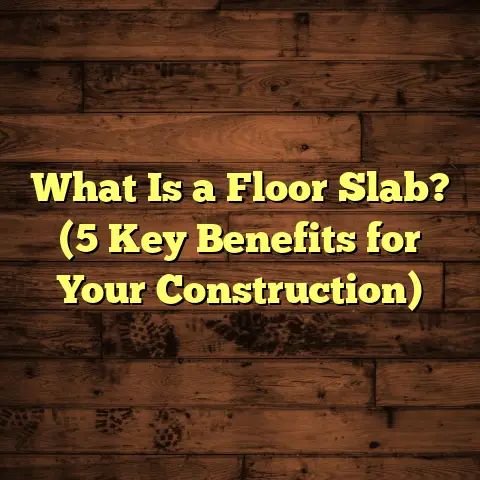What is Stripping and Waxing Floors? (5 Tax Implications Explained)
Let’s get comfortable and talk through what stripping and waxing floors really means, why it matters, how it’s done, and some important tax points you might not know about. I’ll share stories from my own projects, data-backed insights, and even how I budget for these jobs using tools that streamline the whole process.
What Is Stripping and Waxing Floors?
When I explain stripping and waxing floors to someone new to the concept, I start by breaking down the two key parts:
- Stripping: This is the process of removing the old wax buildup, dirt, grime, and sometimes even old finishes that have layered up over time on your floor surface.
- Waxing: After the floor is clean and bare, waxing involves applying fresh layers of protective wax that give the floor a shiny finish and help protect it from wear.
Why Do Floors Need Stripping?
Imagine walking into a room where the floor looks cloudy or has patches that don’t shine anymore. That cloudiness is often old wax getting dirty and breaking down. Over time, wax layers build up unevenly. Dirt gets trapped in them, and the floor loses its luster.
In one project I handled at a community center, the vinyl composite tile floor hadn’t been maintained for years. It was so dull and sticky in places that people were complaining about slipping hazards. Stripping that old wax away was like scrubbing a dirty window until it was clear again.
Stripping usually involves a chemical stripper — a strong solution designed specifically to break down the wax without damaging the flooring underneath. After applying it, you use mechanical agitation (like a floor scrubber or buffer with scrubbing pads) to loosen and lift the wax.
One important note: stripping isn’t just about appearance. It helps prevent buildup that can cause permanent damage or discoloration to the floor material.
Waxing: More Than Just Shine
Once stripped and cleaned, applying wax is what seals the deal. Floor wax acts as a protective barrier against scratches, scuffs, spills, and general wear from foot traffic.
I always tell clients waxing is an investment in longevity — it protects the floor so you don’t have to replace it prematurely. Plus, it makes cleaning easier because dirt won’t stick as much.
Wax comes in different formulations: some are water-based for easier cleanup and less odor; others are solvent-based which generally provide a harder finish but require more ventilation.
The application process usually involves multiple thin coats — too thick at once can cause streaking or bubbling. After each coat dries, buffing with a high-speed machine can bring out a glossy shine.
Types of Floors That Benefit
Not all floors are good candidates for stripping and waxing. Common ones that respond well include:
- Vinyl composite tile (VCT)
- Linoleum
- Terrazzo (sometimes)
- Sealed concrete (wax can be applied but sealers are more common)
- Some hardwood floors that use wax finish rather than polyurethane
I’ve found VCT floors especially common in schools and hospitals because they’re durable but need regular maintenance to stay looking good.
My Personal Journey With Stripping and Waxing
I still remember my first major stripping and waxing job — an old gym floor at a small-town school. The floor was lined with scuff marks, sticky spots where spills had seeped in, and a generally tired look that made the whole gym feel neglected.
I brought in my gear: commercial-grade stripper, scrubber pads, mops, buckets of clean water, and gallons of high-quality wax.
The process was slow at first — stripping off multiple layers of old wax was labor-intensive. The first round removed most of the surface dirt but left some stubborn patches.
By the third round of stripping with careful scrubbing and rinsing, the floor was completely clean. I let it dry overnight and started applying thin coats of wax.
Seeing that floor go from grimy to glossy over several days was incredibly rewarding. The gym felt brighter; kids seemed more energized just by stepping onto a clean floor. The school staff told me it looked as if they’d installed new flooring altogether.
That project taught me early on how essential patience and attention to detail are for stripping and waxing. Skipping or rushing any step leads to poor results — sticky residue, peeling wax, or uneven shine.
The Science Behind Floor Waxing
You might wonder what exactly happens when you apply wax to a floor. Floor wax is typically made from polymers that form a thin film over the surface. This film:
- Protects against abrasion (scratches from shoes or furniture)
- Resists moisture penetration
- Creates a smooth surface that reflects light better (hence the shine)
- Makes cleaning easier by preventing dirt from embedding in the floor material
Wax thickness is key — too thin won’t protect well; too thick can peel or trap dirt.
I’ve used data from flooring manufacturers showing proper wax thickness ranges between 0.5 to 1 millimeter per coat. Most floors need 3-5 coats for optimal protection.
Buffing after waxing compresses the wax layer and polishes it to a uniform shine, which also adds slip resistance—a crucial feature for commercial spaces.
How Often Should You Strip and Wax?
Frequency depends on foot traffic, type of flooring, climate conditions, and maintenance routines.
For example:
- High-traffic commercial spaces: every 6 months to 1 year
- Moderate traffic retail or office: annually
- Low traffic residential: every 2-3 years
Skipping regular maintenance causes buildup of dirt under layers of wax making future stripping harder and more expensive.
In one case study I reviewed from a hospital floor maintenance report (2022), facilities that followed strict stripping/waxing schedules reduced floor replacement costs by 40% over 10 years compared to those with irregular maintenance.
Common Mistakes When Stripping and Waxing Floors
From my experience working with DIYers and pros alike, here are some pitfalls:
- Using too strong or wrong type of stripper damaging flooring
- Inadequate rinsing leaving residue that causes poor adhesion of new wax
- Applying wax in thick coats leading to bubbling or peeling
- Not allowing sufficient drying time between coats
- Ignoring safety precautions around chemical strippers (ventilation is critical)
Avoiding these mistakes ensures longevity and safety.
Cost Considerations: What Does Stripping & Waxing Cost?
Pricing varies widely depending on:
- Floor size
- Condition (how many stripping cycles needed)
- Type of wax used
- Labor rates in your area
On average, professional stripping and waxing runs between $0.50 to $3.00 per square foot.
For example, a 1,000 sq ft office may cost $500-$3,000 depending on complexity.
I usually recommend clients budget for at least $1 per sq ft if floors haven’t been maintained recently because multiple stripping rounds may be required.
This brings me to how I estimate costs efficiently…
How FloorTally Helps Me Manage Flooring Costs
I’ve tried many methods for estimating costs over the years—pen and paper, spreadsheets—but one tool that stands out is FloorTally.
It helps me input local labor rates, material prices (like stripper gallons or wax cans), floor size, and even waste factors (extra materials needed).
FloorTally consolidates everything into one estimate quickly so I can:
- Provide clients with realistic budgets upfront
- Adjust scenarios if they want premium wax versus budget options
- Avoid surprises on material overages or labor hours
It’s not just about pricing—it saves me time calculating quantities of chemicals needed based on floor type.
For example: If I’m planning waxing on 2,000 sq ft of VCT floor with moderate wear, FloorTally will factor in 10% waste allowance for stripper spills or overlapping coats.
This kind of precision means fewer mistakes ordering supplies or underestimating labor time.
Tax Implications Of Stripping And Waxing Floors: What You Should Know
Here’s where things get interesting—and often confusing—for business owners or landlords who pay for these services. Many don’t realize how stripping and waxing expenses affect their taxes.
1. Maintenance Expense vs Capital Improvement
The IRS clearly classifies routine upkeep like stripping and waxing as maintenance expenses—not capital improvements.
What does this mean?
You can deduct maintenance costs fully in the year incurred rather than depreciating over several years like you would for major upgrades.
This immediate deduction helps small businesses reduce taxable income faster.
For example: A restaurant spends $3,000 on stripping/waxing this year — they deduct all $3K right away instead of spreading it over 5+ years.
2. No Increase in Property Basis
Because stripping/waxing doesn’t add measurable value or extend life beyond original expectation significantly (just keeps it in good condition), it doesn’t increase your property’s cost basis for depreciation purposes.
If you replaced floors entirely or installed new flooring material, that cost would be capitalized instead.
3. Deductibility for Rental Properties
Landlords treating stripping/waxing as repairs can deduct expenses directly on Schedule E for rental income tax returns.
It’s important though to distinguish repairs from improvements because improvements must be capitalized.
4. Business Use Percentage Allocation
If your property serves mixed personal/business uses — say part home office — only expenses proportionate to business use can be deducted.
Detailed records showing allocation percentages are necessary during audits.
5. Keep Good Documentation
In my experience helping clients prepare for tax season, keeping invoices showing dates of service, specific work done (“floor stripping & waxing”), and amounts paid is essential.
Good record keeping simplifies deductions and protects you if questioned by tax authorities.
Case Study: Commercial Office Building Floor Maintenance
A client managing a 10,000 sq ft office building wanted advice on ongoing floor care budgeting.
They were spending sporadically on patch repairs rather than regular maintenance so floors looked uneven with dull spots.
We mapped out a schedule:
- Strip & wax every 8 months
- Interim dry buffing every 2 months
They used FloorTally to estimate annual costs at around $15,000 versus unpredictable higher emergency repairs exceeding $25K previously.
After two years following this plan:
- Floors retained consistent shine
- Tenant satisfaction improved
- Property managers noted fewer slip incidents
Tax-wise:
- $15K annual maintenance was deducted fully each year
- Property basis remained unchanged
This steady maintenance approach saved them money long-term both operationally and on taxes.
Comparing Stripping & Waxing To Other Floor Care Options
You might wonder how stripping/waxing compares to other popular methods like polishing or refinishing?
| Method | Pros | Cons | Best For |
|---|---|---|---|
| Stripping & Waxing | Deep cleaning + protection; cost-effective | Labor-intensive; chemical use | Vinyl floors; linoleum; VCT |
| Polishing | Quick shine restoration; less labor | Doesn’t remove old buildup; less durable | Regular interim maintenance |
| Refinishing | Removes scratches completely; long-lasting | Expensive; needs sanding & drying time | Hardwood floors |
| Sealants | Strong moisture barrier | Not glossy; more common on concrete | Concrete & stone surfaces |
Stripping/waxing sits comfortably between polishing (light maintenance) and refinishing (major work).
Personal Tips For DIY Stripping & Waxing
If you’re tackling this yourself at home or small office:
- Use recommended strippers for your floor type
- Test stripper on small patch first
- Ventilate space well while working
- Use mop/buffer appropriate pads
- Apply thin coats of wax gradually
- Allow sufficient drying time between steps
- Avoid heavy furniture until fully cured (usually 24 hours)
I once advised a friend doing DIY waxing on his basement floor who had trouble with sticky patches afterward—he’d skipped rinsing after stripping properly. That one step makes all the difference!
Trends In Floor Maintenance Products
The industry has evolved with environmentally friendly strippers made without harsh solvents becoming more popular due to regulations and indoor air quality concerns.
Water-based waxes now offer lower odors and easier cleanup while delivering comparable durability to solvent-based formulas.
Smart technology like automated scrubbers with sensors helps improve efficiency during stripping phases in large buildings.
Environmental Considerations
Disposing of old wax buildup and chemical strippers requires care since some materials can be hazardous waste depending on local laws.
Using eco-friendly products minimizes environmental impact while still delivering effective results—something I always recommend clients consider balancing performance vs sustainability goals.
Wrapping Up With Some Questions For You
Have you ever seen a floor transformation after stripping/waxing? How did it change your space?
Are you managing commercial or rental properties where these maintenance expenses impact your bottom line?
What challenges have you faced budgeting or scheduling floor care?
Feel free to reach out—I’m happy to share advice based on years working hands-on with floors plus navigating tax rules related to upkeep costs!
If you want your floors looking great while keeping finances smartly managed, stripping and waxing remains one of the best solutions out there—even today.





